The transition from traditional art studies to establishing a career as a young artist is piled high with obstacles. There is need to establish a rhythm for advancing one’s investigations, the managing of connections to a growing art world network, and many unforeseen occurrences. At inception, Zachary Weber appears to be addressing each fully, while maintaining a fearlessness in approach to his studio practice. Weber embraces change and surprises via youthful exploration. This week The COMP Magazine traveled down to Bridgeport to visit Weber in their studio to discuss this transition, the importance of play in their inquiry, the selection of mediums when advancing investigations, and how their studio practice extends beyond the studio into collaborative efforts.
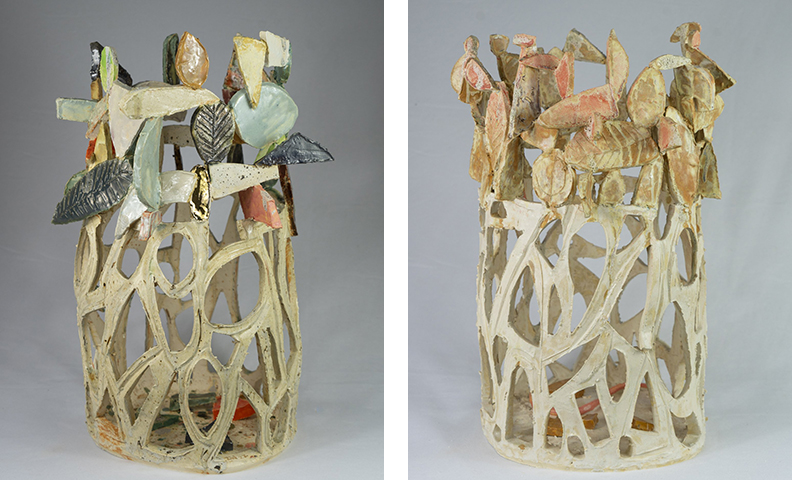
Since completing your studies at The School of the Art Institute of Chicago (SAIC) in 2021 you have established a healthy independent studio practice. I admire your dedication and focus on the inception of your career. Let’s start with your introduction to the visual arts. You grew up in the Chicago. Early on you located an interest in the city’s aesthetic forms, specifically items you encountered in public spaces. Can you share with us any early experiences or individuals who you see impacting this fascination?
The urban environment was an impetus for exploration at an early age. I was always exploring areas of the city (prominently the city’s North-Side). I remember building ‘forts’ of tree-branches and shrubs at Lincoln Park. I sought out areas where life in the city creeped in; a vivid memory of a wild tomato plant growing from between two sidewalk squares, or a duck finding itself in my parents’ backyard after a heavy rainstorm. I always made use of my surroundings as an attempt to understand my world. I don’t think that language has changed one bit. My mother was grieving her late brother when I was six or seven. During those times, I would console her by picking flowers from neighbors’ yards, the park, and random locations around the neighborhood into one bouquet. Looking back, I believe I was trying to show her beauty. Beauty everywhere; in all colors, scents, and jurisdictions. I think without a wandering curiosity beauty is hard to come by.
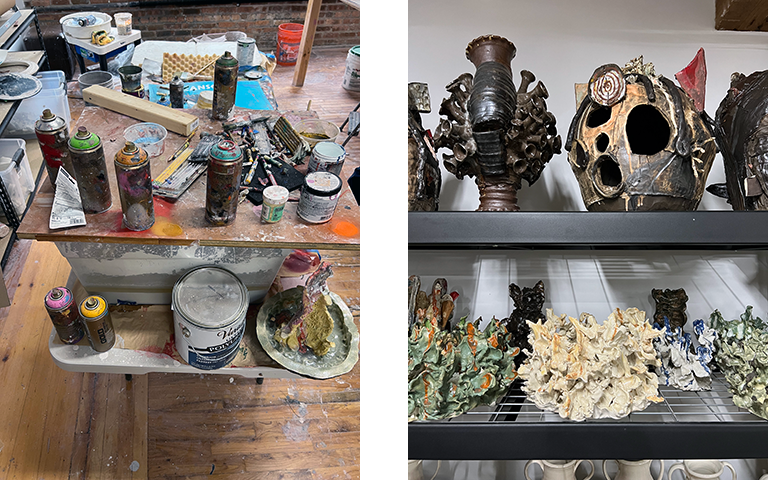
At SAIC you studied photography. However, you work in a variety of mediums (ceramics, drawing, painting, and sculpture). Can you share your thoughts on your selection of mediums and how these choices influence the intent of the experience or message you hope to convey?
I try to think less about the material or medium and more about the use of which. Clay, paper, canvas, the camera, and perhaps this writing are just bricks; subject matter is the grout; ‘meaning’ is its utility. Everything for me is an investigation of figuring out what works how, within and between its and my own parameters. Clay and photography offer two distinct material limitations. It’s the challenge of understanding these limitations and how they function within my own investigative use that appeals to me because it is uncertain. Gravity is not a large factor in photography, but it is of constant consideration in ceramics, therefore I need to respect these inherent rules and make something with them (like the tomato growing from the sidewalk). Conceptually, I look at this understanding as an homage unto itself at times; and perhaps it is often what we appreciate (when we see art that defy’s its own categorization). I do so within my own subjective ruleset (‘the maker’). Almost like the bouquets, I want to make work that collects beauty from as many points of perception. I think when I sacrifice control within what I am making work with, I have a more sincere encounter with the process. It is the process of finding the flowers that the bouquet signifies. Likewise, I need not think of my decisions in order to create, I just need to do something or go somewhere. I think making art [good art] is an ultimate embrace of inevitable change.
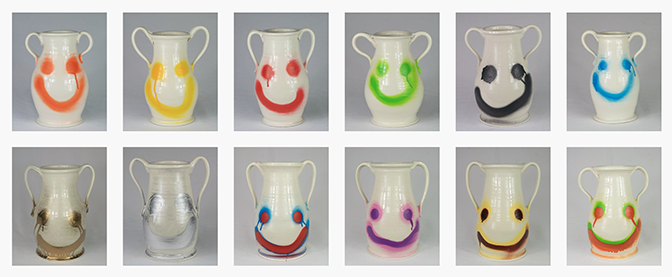
I’m a fan of the intersection play with the fine arts. This idea appears to surface in the series Smiley Vases and your tactile approach in other ceramic-based analysis. Do you see play entering your studio investigations? Can you describe your process in terms of the applied and conceptual systems?
I think that play is just another word for investigation. With an investigation, there seems to be that there is always more actualisation through the participation [searching] alone. It’s the act of connecting otherwise desperate systems into one whole. Porcelain and spray paint is an example of two distinct mediums converging into one message. As an artist, I try to facilitate concoctions; I don’t think this is possible without experimentation. Play/investigation is ultimate one-ness for me. In the studio, that may mean an overcoming of self-doubt and/or succeeding to technical limitations. I think self-doubt is the enemy of play whereas technical limitations enable play (think of the rigid rules with making a puzzle). A puzzle cannot function if it is not without the cooperation of each piece lined perfectly within each groove; it is not functioning without our own voluntary cooperation to investigate* every possible scenario of connection.
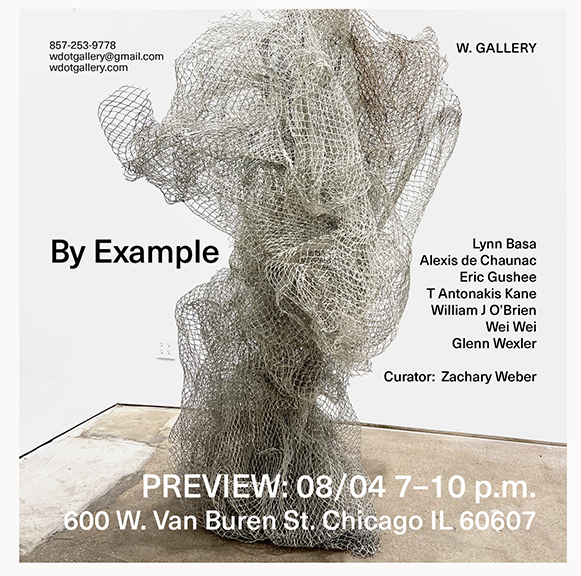
In addition to your studio production, you are exploring curatorial practices. In this effort, recently, you have worked with an array of artists, Lynn Basa, Alexis De Chaunac, Eric Gushee, T. Antonakis Kane, William J. Obrien, Wei Wei, and Glen Wexler on the exhibition By Example, also at W. Gallery. What piqued this interest? What was the intent of this exhibition? Do you plan to continue this mode of inquiry?
By Example was a show that questioned our relationship with sincerity. In more ways than one, I wanted the artists, myself, and the viewers to ask themselves how is you*r work sincere? I wanted to pick at some underlying theories I gathered through my own relationship with talk therapy and apply that to curation. I wanted to make a show based on self-reflection. If we ask this of our audience, we as artists must ask this of ourselves. I believe that is an ethical obligation.
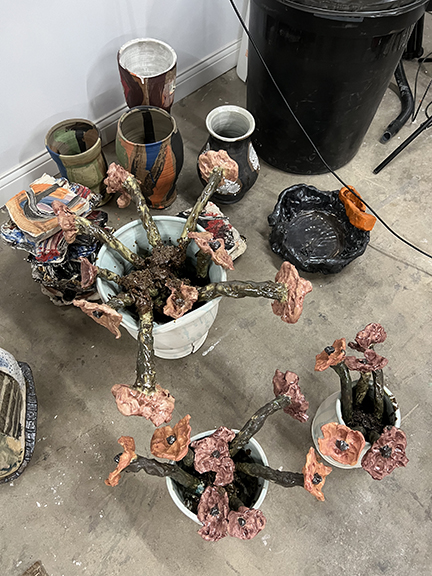
At this early stage, what do you value most in your aesthetic investigations and studio practice?
I value change the most. I want my work to surprise me, constantly. I think an ‘aesthetic investigation’ is a very fitting term for my practice as whole. I think we all think in terms of aesthetics. It is what makes us ‘us’. For me, making work that expands the parameters of my own understanding takes place from an aesthetic language that is constantly changing, and to which I have no direct control of. I want to not be able to explain this language; the moment I do, the work is already understood, and if the work is already understood, there remains no more reason to engage with it. I think we are drawn to the unknown.
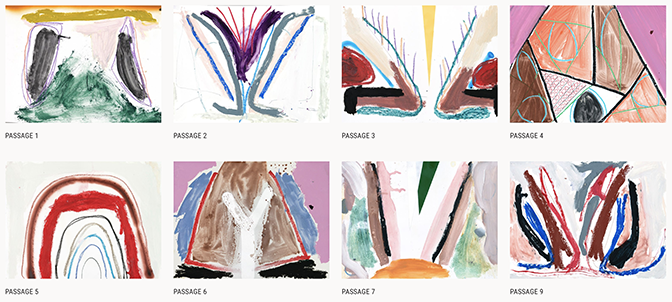
You appear to have had a whirlwind of a start since completing your studies. What are you currently working upon? What’s the plan for the remainder of 2023? Do you have any specific projects you hope to start in 2024?
Keeping on making and to be grateful.
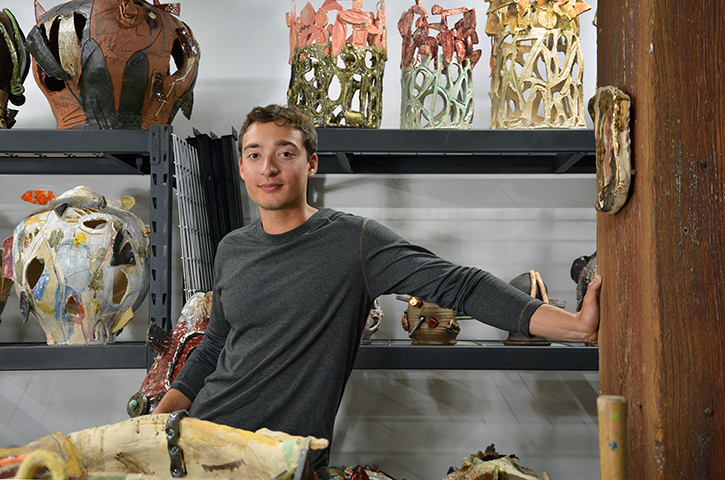
For additional information on the aesthetic practice of Zachary Weber, please visit:
Zachary Weber – https://www.zweberart.com/
Zachary Weber on Instagram – https://www.instagram.com/mudandfire/?hl=en
Pavilion Antiques – https://pavilionantiques.com/zachary-weber
Incollect – https://www.incollect.com/artists/zachary-weber
River North Design District – https://rivernorthdesigndistrict.com/zachary-weber-fine-art/
W. Gallery – https://www.wdotgallery.com/recursivelanguage
Artist interview and portrait by Chester Alamo-Costello


